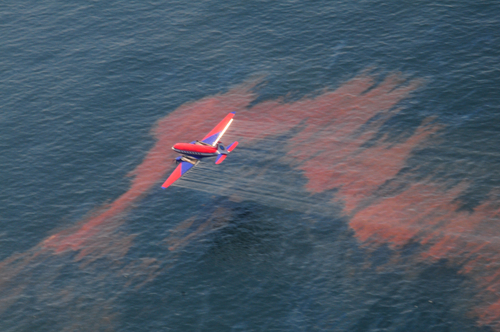 BP’s CEO Tony Hayward has come up with the ultimate excuse for the spill in the Gulf of Mexico, claiming it is “relatively tiny” compared with the “very big ocean”.
BP’s CEO Tony Hayward has come up with the ultimate excuse for the spill in the Gulf of Mexico, claiming it is “relatively tiny” compared with the “very big ocean”.
In an interview with the Guardian newspaper, Hayward tried to claim that the spill should be put into context.
“The Gulf of Mexico is a very big ocean. The amount of volume of oil and dispersant we are putting into it is tiny in relation to the total water volume”.
The incredulity of this argument beggars belief. Oil is toxic. The dispersants are toxic (quite how toxic we don’t know as they have not even done basic toxicity tests).
Try running that line of argument with the dying birds, dead fish and other suffocating wildlife.
Try telling the baby shrimps, and spawning fish who will swim into a toxic soup of oil and dispersant, now spread throughout the water column across hundreds of miles of the Gulf of Mexico.
Try telling the numerous fisherman and tourist guides whose lives are now ruined, in the short term at least. Try telling the communities across the American Gulf States – already stretched by Katrina’s legacy – that “Don’t worry, mate. Its only a drop in the ocean.”
But actually it is quite a big drop, we are finally finding out. Even yesterday when Mark was blogging on the site, the estimates were anything from 5,000 to 25,000 barrels a day.
But that estimate has now nearly trebled.
We now know that BP conceded privately to Congress that the worst case, if the leak accelerated, would be 60,000 barrels a day.
But that could have already been exceeded, according to scientists.
Scientists studying the video footage of oil pouring our of the broken pipe have nowe suggested that some 70,000 barrels daily could be pouring out.
That is the equivalent to an Exxon Valdez every four days, and 12 times more powerful than estimates by Coast Guard or BP
The new analysis was conducted by Steve Werely, an associate professor at Purdue University, using a technique called particle image velocimetry, a method was accurate to 20%. That puts the range of the oil spill from 56,000 to 84,000 barrels a day.
Other scientists have calculated similar ranges: Eugene Chiang, an associate professor at the University of California Berkeley who teaches a course on measurement, has told the Guardian that a “back of the envelope” calculation put an estimated rate for the spill at 20,000 to 100,000 barrels a day.
“This was just based on back-of-the-envelope scribbling and looking at the vide; but even within that range you can already infer that this is a huge disaster exceeding the magnitude of the Exxon Valdez spill by quite a large margin,” he said. “The calculation is uncertain, but I am confident enough to say that this is one of the big ones. It is not 5,000 barrels a day. That much I can say.”
Ian R. MacDonald, an oceanographer at Florida State University, an expert in the analysis of oil slicks, has used a different technique. Using satellite satellite imagery he argues that the leak could “easily be four or five times” the government estimate.
And lets not forget the nearly half a million gallons of dispersant that has now been sprayed too adding to the toxic soup, slowly spreading across the Gulf of Mexico.
But don’t worry, that is only a drop in the ocean too.

Drop into the Ocean
Money all ways the concern; but the planet not that big in our Constellation, and the environment getting worse any were around the World. I can’t understand humans any more; doing so much to destroy anything that is alive included human beings.
We cannot carry on with so much stupidity; just because egoism is the principal cause towards our completely destruction. I cannot blame one person; but all of them in all Governments around the World. ( Egoism the main factor) Money and more money